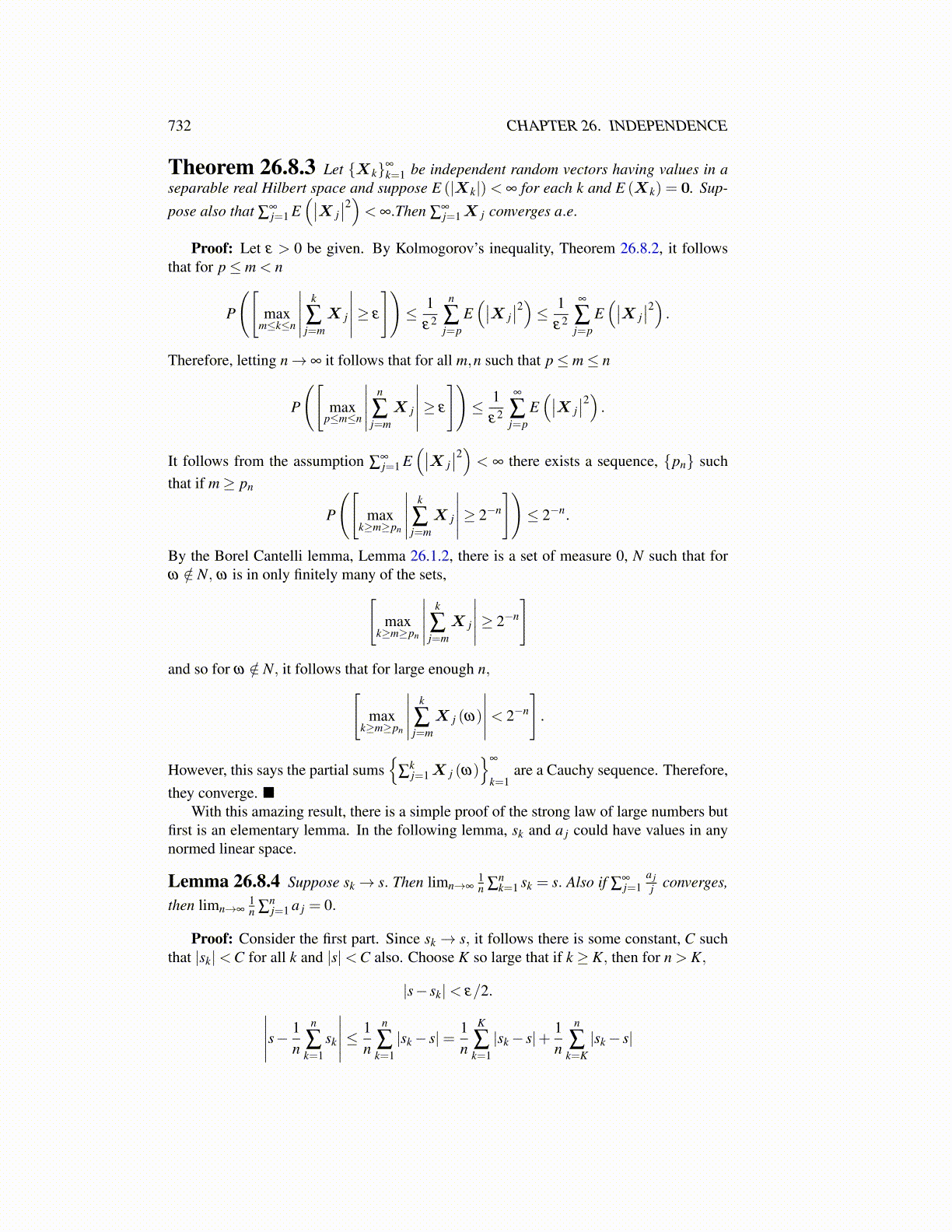
732 CHAPTER 26. INDEPENDENCE
Theorem 26.8.3 Let {Xk}∞
k=1 be independent random vectors having values in aseparable real Hilbert space and suppose E (|Xk|)< ∞ for each k and E (Xk) = 0. Sup-
pose also that ∑∞j=1 E
(∣∣X j∣∣2)< ∞.Then ∑
∞j=1X j converges a.e.
Proof: Let ε > 0 be given. By Kolmogorov’s inequality, Theorem 26.8.2, it followsthat for p≤ m < n
P
([max
m≤k≤n
∣∣∣∣∣ k
∑j=mX j
∣∣∣∣∣≥ ε
])≤ 1
ε2
n
∑j=p
E(∣∣X j
∣∣2)≤ 1ε2
∞
∑j=p
E(∣∣X j
∣∣2) .Therefore, letting n→ ∞ it follows that for all m,n such that p≤ m≤ n
P
([max
p≤m≤n
∣∣∣∣∣ n
∑j=mX j
∣∣∣∣∣≥ ε
])≤ 1
ε2
∞
∑j=p
E(∣∣X j
∣∣2) .It follows from the assumption ∑
∞j=1 E
(∣∣X j∣∣2) < ∞ there exists a sequence, {pn} such
that if m≥ pn
P
([max
k≥m≥pn
∣∣∣∣∣ k
∑j=mX j
∣∣∣∣∣≥ 2−n
])≤ 2−n.
By the Borel Cantelli lemma, Lemma 26.1.2, there is a set of measure 0, N such that forω /∈ N, ω is in only finitely many of the sets,[
maxk≥m≥pn
∣∣∣∣∣ k
∑j=mX j
∣∣∣∣∣≥ 2−n
]
and so for ω /∈ N, it follows that for large enough n,[max
k≥m≥pn
∣∣∣∣∣ k
∑j=mX j (ω)
∣∣∣∣∣< 2−n
].
However, this says the partial sums{
∑kj=1X j (ω)
}∞
k=1are a Cauchy sequence. Therefore,
they converge. ■With this amazing result, there is a simple proof of the strong law of large numbers but
first is an elementary lemma. In the following lemma, sk and a j could have values in anynormed linear space.
Lemma 26.8.4 Suppose sk→ s. Then limn→∞1n ∑
nk=1 sk = s. Also if ∑
∞j=1
a jj converges,
then limn→∞1n ∑
nj=1 a j = 0.
Proof: Consider the first part. Since sk → s, it follows there is some constant, C suchthat |sk|<C for all k and |s|<C also. Choose K so large that if k ≥ K, then for n > K,
|s− sk|< ε/2.∣∣∣∣∣s− 1n
n
∑k=1
sk
∣∣∣∣∣≤ 1n
n
∑k=1|sk− s|= 1
n
K
∑k=1|sk− s|+ 1
n
n
∑k=K|sk− s|